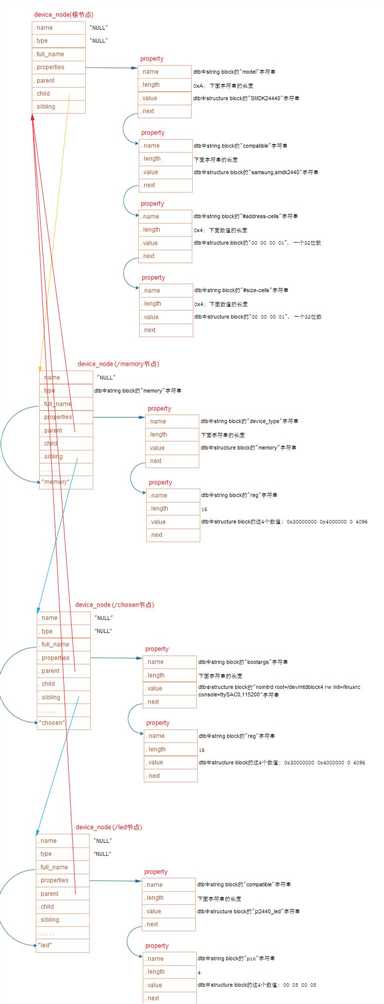标签:长度 handle 使用 noi locate oca 过程 dea microsoft
device_node只是某个结构体而已。
在uboot中把设备树文件随表放入内存中的某个地方就可以使用,为什么内核运行过程中它不会覆盖dtb文件所占用的那块内存呢?
在设备树格式那篇文章中曾经说过,在设备树文件中可以用memreserve指定一块内存,这块内存就是保留下来的内存,内核不会占用它。即使没有指定这块内存,当内核启动的时候,它也会把设备树文件所在的那块内存保留出来。
看一下函数的调用过程:
start_kernel // init/main.c
setup_arch(&command_line); // arch/arm/kernel/setup.c
arm_memblock_init(mdesc); // arch/arm/kernel/setup.c
early_init_fdt_reserve_self();
/* Reserve the dtb region */
// 把DTB所占区域保留下来, 即调用: memblock_reserve
early_init_dt_reserve_memory_arch(__pa(initial_boot_params),
fdt_totalsize(initial_boot_params),
0);
early_init_fdt_scan_reserved_mem(); // 根据dtb中的memreserve信息, 调用memblock_reserve
unflatten_device_tree(); // arch/arm/kernel/setup.c
__unflatten_device_tree(initial_boot_params, NULL, &of_root,
early_init_dt_alloc_memory_arch, false); // drivers/of/fdt.c
/* First pass, scan for size */
size = unflatten_dt_nodes(blob, NULL, dad, NULL);
/* Allocate memory for the expanded device tree */
mem = dt_alloc(size + 4, __alignof__(struct device_node));
/* Second pass, do actual unflattening */
unflatten_dt_nodes(blob, mem, dad, mynodes);
populate_node
np = unflatten_dt_alloc(mem, sizeof(struct device_node) + allocl,
__alignof__(struct device_node));
np->full_name = fn = ((char *)np) + sizeof(*np);
populate_properties
pp = unflatten_dt_alloc(mem, sizeof(struct property),
__alignof__(struct property));
pp->name = (char *)pname;
pp->length = sz;
pp->value = (__be32 *)val;
flatten是扁平的,dtb文件是扁平的,里面含有各个设备节点,需要将它们提取出来,构成一棵树。
unflatten_device_tree函数是本篇文章分析的重点。首先看两个结构体:
device_node结构体:
每一个节点都转换为一个device_node结构体:
struct device_node {
const char *name; // 来自节点中的name属性, 如果没有该属性, 则设为"NULL"
const char *type; // 来自节点中的device_type属性, 如果没有该属性, 则设为"NULL"
phandle phandle;
const char *full_name; // 节点的名字, node-name[@unit-address]
struct fwnode_handle fwnode;
struct property *properties; // 节点的属性
struct property *deadprops; /* removed properties */
struct device_node *parent; // 节点的父亲
struct device_node *child; // 节点的孩子(子节点)
struct device_node *sibling; // 节点的兄弟(同级节点)
#if defined(CONFIG_OF_KOBJ)
struct kobject kobj;
#endif
unsigned long _flags;
void *data;
#if defined(CONFIG_SPARC)
const char *path_component_name;
unsigned int unique_id;
struct of_irq_controller *irq_trans;
#endif
};
在dts文件中,每一个大括号代表一个节点,比如说根节点,它会对应一个device_node结构体。
memory它也有一个大括号,也对应着一个device_node结构体。
chosen它也有一个大括号,也对应着一个device_node结构体。
在一个节点里面,有可能还有子节点,有一些父子关系,兄弟关系。在device_node中肯定肯定有成员来描述这些关系
device_node结构体中有properties, 用来表示该节点的属性
每一个属性对应一个property结构体:
struct property {
char *name; // 属性名字, 指向dtb文件中的字符串
int length; // 属性值的长度
void *value; // 属性值, 指向dtb文件中value所在位置, 数据仍以big endian存储
struct property *next;
#if defined(CONFIG_OF_DYNAMIC) || defined(CONFIG_SPARC)
unsigned long _flags;
#endif
#if defined(CONFIG_OF_PROMTREE)
unsigned int unique_id;
#endif
#if defined(CONFIG_OF_KOBJ)
struct bin_attribute attr;
#endif
};
以下面的设备树为例,进行分析:
/dts-v1/;
/ {
model = "SMDK24440";
compatible = "samsung,smdk2440";
#address-cells = <1>;
#size-cells = <1>;
memory@30000000 {
device_type = "memory";
reg = <0x30000000 0x4000000>;
};
/*
cpus {
cpu {
compatible = "arm,arm926ej-s";
};
};
*/
chosen {
bootargs = "noinitrd root=/dev/mtdblock4 rw init=/linuxrc console=ttySAC0,115200";
};
led {
compatible = "jz2440_led";
pin = <S3C2410_GPF(5)>;
};
};

标签:长度 handle 使用 noi locate oca 过程 dea microsoft
原文地址:https://www.cnblogs.com/-glb/p/12354415.html